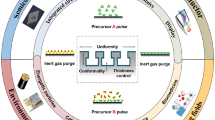Abstract
In this paper, fabrication methods are developed in order to realize the silicon microelectromechanical systems components with new shapes in {100} Si wafers. Fabrication process utilizes wet etching with a single step of photolithography. The silicon etching is carried out in complementary metal oxide semiconductor process compatible pure and surfactant Triton-X-100 [C14H22O(C2H4O] n , n = 9–10) added tetramethylammonium hydroxide (TMAH) solutions. The fabricated structures are divided in two categories: fixed and freestanding. The fixed structures are realized in single oxidized silicon wafers, while freestanding are formed in silicon nitride-based silicon on insulator (SOI) wafers. The SOI wafers are prepared by bonding the oxidized and the nitride deposited wafers, followed by thinning and chemical mechanical polishing processes. The etching results such as {100} and {110}Si etch rates, undercutting at rounded concave and sharp convex corners and etched surface morphologies are measured in both pure and Triton added TMAH solutions. Different concentrations of TMAH are used to optimize the etching conditions for desired etched profiles.













Similar content being viewed by others
References
Abedinov N, Grabiec P, Gotszalk T, Ivanov T, Voigt J, Rangelow IW (2001) Micromachined piezoresistive cantilever array with integrated resistive microheater for calorimetry and mass detection. J Vac Sci Technol A 19:2884–2888. doi:10.1116/1.1412654
Bhardwaj J, Ashraf H, McQuarrie A (1997) Dry silicon etching for MEMS, proceedings of the 191st meeting Electrochemical Society. In: Proceeding of microstructures and microfabricated systems III symposium, Montreal, pp 118–130
Conway EM, Cunnane VJ (2002) Electrochemical characterization of Si in tetra-methyl ammonium hydroxide (TMAH) and TMAH:Triton-X-100 solutions under white light effects. J Micromech Microeng 12:136–148. doi:10.1088/0960-1317/12/2/307
Ismail MS, Bower RW, Veteran JL, Marsh OJ (1990) Silicon nitride direct bonding. Electron Lett 26:1045–1046. doi:10.1049/el:19900677
Jeon JS, Raghavan S, Carrejo JP (1996) Effect of temperature on the interaction of silicon with nonionic surfactants in alkaline solutions. J Electrochem Soc 143:277–283
Merlos A, Acero MC, Bao MH, Bausells J, Esteve J (1992) A study of the undercutting characteristics in the TMAH:IPA system. J Micromech Microeng 2:181–183. doi:10.1088/0960-1317/2/3/014
Pal P, Sato K (2009a) Silicon microfluidic channels and microstructures in single photolithography step. In: Proceeding of symposium on design, test, integration and packaging of MEMS and MOEMS (DTIP-2009). Rome, Italy, pp 415–419
Pal P, Sato K (2009b) Suspended Si microstructures over controlled depth micromachined cavities for MEMS based sensing devices. Sens Lett 7:11–16. doi:10.1166/sl.2009.1003
Pal P, Kim YJ, Chandra S (2006) Front-to-back alignment techniques in microelectronics/MEMS fabrication: a review. Sens Lett 4:1–10. doi:10.1166/sl.2006.007
Pal P, Sato K, Chandra S (2007a) Fabrication techniques of convex corners in a (100)-silicon wafer using bulk micromachining: a review. J Micromech Microeng 17:R111–R133. doi:10.1088/0960-1317/17/10/R01
Pal P, Sato K, Gosalvez MA, Shikida M (2007b) Study of rounded concave and sharp edge convex corners undercutting in CMOS compatible anisotropic etchants. J Micromech Microeng 17:2299–2307. doi:10.1088/0960-1317/17/11/017
Pal P, Sato K, Shikida M, Gosalvez MA (2009) Study of corner compensating structures and fabrication of various shapes of MEMS structures in pure and surfactant added TMAH. Sens Actuators A 154:192–203. doi:10.1016/j.sna.2008.09.002
Resnik D, Vrtacnik D, Aljancic U, Mozek M, Amon S (2005) The role of Triton surfactant in anisotropic etching of 110 reflective planes on (100) silicon. J Micromech Microeng 15:1174–1183. doi:10.1088/0960-1317/15/6/007
Sanchez S, Gui C, Elwenspoek M (1997) Spontaneous direct bonding of thick silicon nitride. J Micromech Microeng 7:111–113. doi:10.1088/0960-1317/7/3/007
Sarro PM, Brida D, Vander Vlist W, Brida S (2000) Effect of surfactant on surface quality of silicon microstructures etched in saturated TMAHW solutions. Sens Actuators A 85:340–345. doi:10.1016/S0924-4247(00)00317-4
Sekimura M (1999) Anisotropic etching of surfactant-added TMAH solution. In: Proceedings of the. 12th IEEE Micro-Electro-Mech System conference, Orlando, Florida, pp 17–21
Sundaram KB, Vijayakumar A, Subramanian G (2005) Smooth etching of silicon using TMAH and isopropyl alcohol for MEMS applications. Microelectron Eng 77:230–241. doi:10.1016/j.mee.2004.11.004
Tong QY, Gosele U (1999) Semiconductor wafer bonding: science and technology. Wiley, New York
Wiegand M, Reiche M, Gosele U, Gutjahr K, Stolze D, Longwitz R, Hiller E (2000) Wafer bonding of silicon wafers covered with various surface layers. Sens Actuators A 86:91–95. doi:10.1016/S0924-4247(00)00420-9
Wu Q, Lee M, Liu CC (1993) Development of chemical sensors using microfabrication and micromachining techniques. Sens Actuators B 13/14:1–6. doi:10.1016/0925-4005(93)85310-7
Yang CR, Yang CH, Chen PY (2005) Study on anisotropic silicon etching characteristics in various surfactant-added tetramethyl ammonium hydroxide water solutions. J Micromech Microeng 15:2028–2037. doi:10.1088/0960-1317/15/11/006
Zubel I, Kramkowska M (2001) The effect of isopropyl alcohol on etching rate and roughness of (100) Si surface etched in KOH and TMAH solutions. Sens Actuators A 93:138–147. doi:10.1016/S0924-4247(01)00648-3
Acknowledgments
This work was supported by Japan Society of the Promotion of Science (JSPS) through a foreign postdoctoral research fellowship scheme (2008–2010, fellowship ID No. 08053), and grant-in-aid for scientific research (A) 19201026, 70008053 from MEXT. We are grateful to Prof. Norikazu Suzuki for providing the chemical mechanical polishing (CMP) facility and for suggestions about how to use it successfully.
Author information
Authors and Affiliations
Corresponding author
Rights and permissions
About this article
Cite this article
Pal, P., Sato, K. Fabrication methods based on wet etching process for the realization of silicon MEMS structures with new shapes. Microsyst Technol 16, 1165–1174 (2010). https://doi.org/10.1007/s00542-009-0956-5
Received:
Accepted:
Published:
Issue Date:
DOI: https://doi.org/10.1007/s00542-009-0956-5




